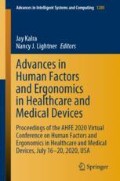Abstract
The National Research Council’s Healthcare Comes Home Report encourages system engineering involvement in homecare research and development to provide medical device designers information on demands associated with homecare and the capabilities needed for non-clinical caregivers to perform successfully The objective of this study was to develop invasive therapy evaluation techniques with human factors considerations for pediatric medical devices, specifically home parenteral nutrition and home mechanical ventilation, to minimize undesirable outcomes in non-clinical settings. The method used was the case study approach to qualitative research through expert interviews, environmental observations and document review data collection methods as well as cross-case themes analysis. This discussion reviews the rated impact of human factors consideration on the safety and effectiveness outcomes of invasive therapy devices use on pediatric patients in non-clinical environment.
Access this chapter
Tax calculation will be finalised at checkout
Purchases are for personal use only
References
Story, M.: FDA perspectives on human factors in device development. Presentation, RAPS Webinar (2012). https://www.fda.gov/media/84709/download
Creswell, J., Creswell, J.: Qualitative Inquiry and Research Design: Choosing Among Five Approaches, 3rd edn. SAGE Publications, Los Angeles (2013)
Cambridge Dictionary. https://dictionary.cambridge.org/us
Ives, C., Hillier, S.: Human factors in healthcare: common terms: CHFG - Clinical Human Factors Group (2016). https://chfg.org/human-factors-in-healthcare-common-terms/
Author information
Authors and Affiliations
Corresponding authors
Editor information
Editors and Affiliations
Rights and permissions
Copyright information
© 2020 The Editor(s) (if applicable) and The Author(s), under exclusive license to Springer Nature Switzerland AG
About this paper
Cite this paper
Gray, J., Meshkati, N., Takata, G., Lawlor, M., Imada, A. (2020). Human Factors Components of Invasive Medical Devices in Non-clinical Environments. In: Kalra, J., Lightner, N. (eds) Advances in Human Factors and Ergonomics in Healthcare and Medical Devices. AHFE 2020. Advances in Intelligent Systems and Computing, vol 1205. Springer, Cham. https://doi.org/10.1007/978-3-030-50838-8_29
Download citation
DOI: https://doi.org/10.1007/978-3-030-50838-8_29
Published:
Publisher Name: Springer, Cham
Print ISBN: 978-3-030-50837-1
Online ISBN: 978-3-030-50838-8
eBook Packages: EngineeringEngineering (R0)

